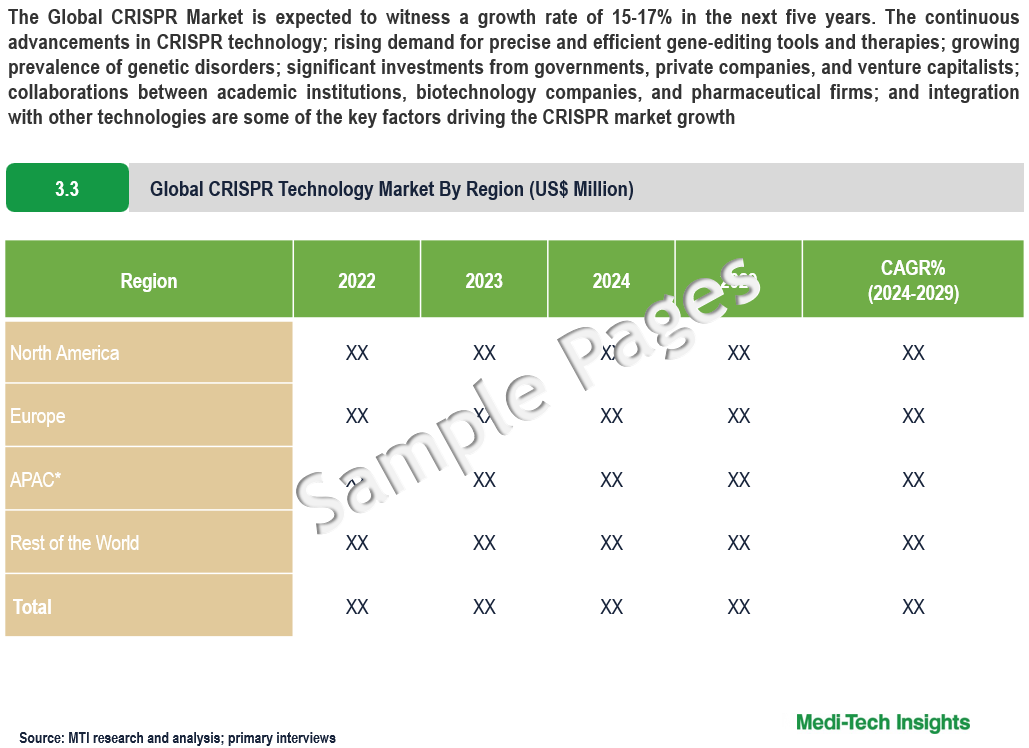
Global CRISPR Technology Market Size, Share, Trends, Demand & Growth Analysis for Forecast 2024 to 2029

The Global CRISPR Technology Market is expected to witness a growth rate of 15-17% in the next five years. The continuous advancements in CRISPR technology; rising demand for precise and efficient gene-editing tools and therapies; growing prevalence of genetic disorders; significant investments from governments, private companies, and venture capitalists; collaborations between academic institutions, biotechnology companies, and pharmaceutical firms to facilitate advancements and commercialization of CRISPR-based products; and integration with other technologies like artificial intelligence (AI) and nanotechnology are some of the key factors driving the CRISPR technology market growth. However, ethical and regulatory concerns, technical limitations, and the high cost associated with CRISPR diagnostics and gene-editing tools is likely to hinder the market’s growth. To learn more about the research report, download a sample report.
CRISPR (Clustered Regularly Interspaced Short Palindromic Repeats) is a gene-editing technology that allows researchers to selectively and precisely modify the DNA of living organisms. Some of the key applications of CRISPR, include generating animal models for research, conducting functional genomic screens, and developing potential treatments for genetic disorders, infectious diseases, and cancer among others.
Growing Investments from Governments, Private Companies, and Venture Capitalists to Drive Market Growth
In recent years, fundings and investments in CRISPR technology have been significant, showcasing the growing interest and support for this innovative field. One notable example is the Indian biotechnology start-up CrisprBits, which raised USD 250,000 in pre-seed funding from US-based VJ Group in February 2023. This funding is intended for developing CRISPR-based diagnostics to detect pathogens and antimicrobial resistance genes. Likewise, in July 2023, Pfizer Inc. made a USD 25 million equity investment in Caribou Biosciences, Inc. a leading clinical-stage CRISPR genome-editing biopharmaceutical company. These examples highlight the substantial financial support and confidence in the potential of CRISPR technology.
“Globally, venture capitalists invested USD 1.08 billion in 31 CRISPR start-up financings in 2022, up from USD 172.9 million in 18 deals in 2021. The allure lies in the efficiency, specificity and simplicity of Crispr gene editing. This technology is poised to become one of these very fundamental, pervasive technologies. This surge in investment is fuelling innovation and a hunt for valuable intellectual property."- Partner, A Global Venture Capital Firm, United States
Precision and Efficiency Associated with CRISPR Technology to Fuel Market Growth
CRISPR has rapidly become the most popular gene-editing tool among scientists in fields such as medicine, agriculture, and microbiology. The rising demand for precise and efficient gene-editing tools and therapies is a major driver of growth in the CRISPR technology market. CRISPR technology offers several advantages over other gene editing tools, making it an attractive option for various applications. CRISPR allows for highly targeted gene editing with minimal off-target effects, enabling precise modifications to DNA sequences. This precision is crucial for developing safe and effective gene therapies. CRISPR is more efficient at modifying genes, with higher success rates as compared to other gene editing tools, making it a preferred choice for researchers and developers. CRISPR can be used for a wide range of applications, including gene knockouts, gene insertions, gene corrections, and gene regulation. Its versatility allows it to be applied in various fields, such as drug discovery, agriculture, and diagnostics. Moreover, ongoing research and development have led to improvements in CRISPR technology, such as enhanced specificity, reduced off-target effects, and expanded applications. These advancements further drive the demand for CRISPR-based tools and therapies.
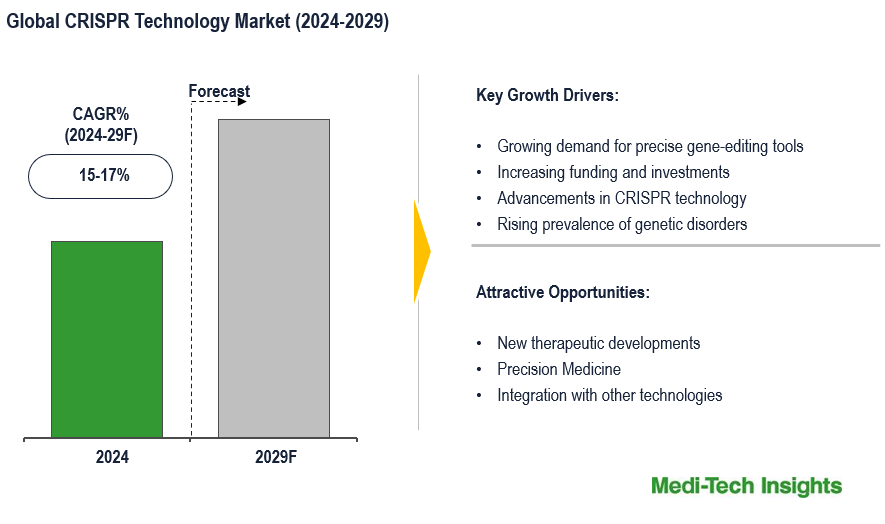
To learn more about this report, download the PDF brochure
Technological Innovations are Driving the CRISPR Technology Market
The CRISPR technology market is technology-driven and is marked by constant product innovations. For instance,
- In November 2023, Vertex Pharmaceuticals Incorporated and CRISPR Therapeutics received USFDA approval for CASGEVY a CRISPR/Cas9 genome-edited cell therapy, for the treatment of sickle cell disease (SCD) in patients 12 years and older with recurrent vaso-occlusive crises (VOCs). This is the first CRISPR-based gene-editing therapy to be approved in the US
- In April 2022, Thermo Fisher Scientific launched the Gibco CTS TrueCut Cas9 Protein, a high-quality Cas9 protein that offers consistent high-editing efficiency across cell lines and greater than 90% efficiency in human primary T-cells, making it an attractive solution for CAR T-cell therapy research using CRISPR-Cas9 genome editing
- In June 2021, QIAGEN launched QIAprep& CRISPR Kit and CRISPR Q-Primer Solutions, enabling researchers to swiftly and efficiently analyze edited genetic material to assess the impact of their interventions on DNA sequence function.
- In April 2019, GenScript launched a new single-stranded DNA (ssDNA) service for CRISPR-based gene editing, providing researchers with high-quality, pure ssDNA to accelerate the development of gene therapy, cell therapy, and transgenic animal models for cancer research and treatment.
US Expected to be a Major Growth Engine in CRISPR Technology Market
US is expected to be a major growth engine in the CRISPR technology market. With the increasing number of ongoing clinical trials and the development of novel therapeutics, US is poised to maintain a dominating position in the market over the forecast period. The country has been at the forefront of CRISPR technology adoption, with significant investments in research and development, particularly in the field of genome editing. Additionally, the first trial in the United States to test a CRISPR-made cancer therapy was launched in 2019, showcasing the country’s commitment to advancing CRISPR applications. This proactive approach, coupled with a robust healthcare infrastructure and supportive regulatory environment, positions US as a key player in driving the growth of the global CRISPR technology market.
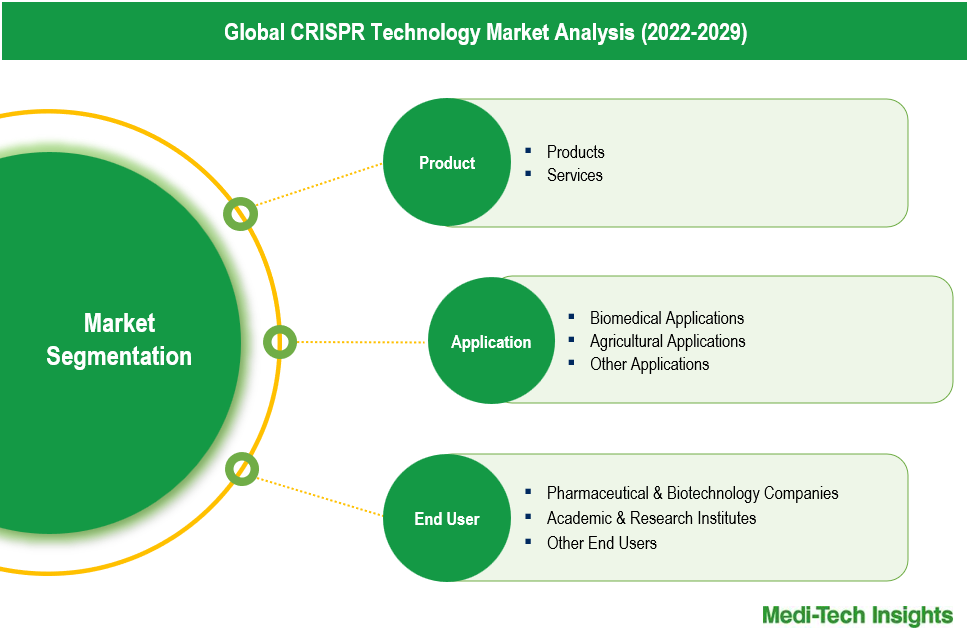
To learn more about this report, download the PDF brochure
Product Type Segment Analysis
The CRISPR technology market comprises two main product types: Products and Services. The product segment which includes CRISPR enzymes and kits, CRISPR libraries and other products; is likely to dominate the market due to growing demand for advanced genetic research tools. Moreover, the ease of use, speed, and cost-effectiveness of CRISPR technology products that have made gene editing more accessible, driving their adoption. Additionally, the increasing investments in research and development, along with the development of novel therapeutics, further contribute to the growth of the CRISPR technology products market
On the other hand, services segment is driven by preference of many research institutions and biotech companies for outsourcing CRISPR-related tasks to specialized service providers to save time and reduce costs associated with setting up in-house capabilities.
Application Type Segment Analysis
The CRISPR technology market can be analyzed based on application types, such as Biomedical, Agricultural and other applications. The biomedical applications segment is expected to dominate the market. The increasing demand for personalized medicine and gene therapies to treat genetic disorders and diseases like cancer is a major driver of the CRISPR technology market in the biomedical field. The rising prevalence of genetic diseases and the need for more effective treatments, combined with advancements in gene therapy and the development of CRISPR-based therapeutics, are further contributing to market growth. Additionally, growing investments and funding from governments and private entities for CRISPR research and development are supporting innovation and adoption in the biomedical sector. In the agriculture sector, CRISPR technology is being harnessed for crop improvement, enhancing disease resistance, and addressing various agricultural challenges. The ability to develop genetically modified crops with improved yield, pest resistance, and nutritional value is a key factor driving market growth
Organic and Inorganic Growth Strategies Adopted by Players to Establish Their Foothold in the Market
Players operating in this market are adopting both organic and inorganic growth strategies such as collaborations, acquisitions, and new product launches to garner market share. For instance,
- In January 2024, Danaher and Innovative Genomics Institute (IGI), entered into a partnership to accelerate the development of gene-editing therapies for rare diseases and genetic disorders. This collaboration, known as the Danaher-IGI Beacon for CRISPR Cures, aims to create a new model for the future development of genomic medicines by using CRISPR-based gene editing to address a wide range of diseases
- In December 2023, Editas Medicine and Vertex Pharmaceuticals entered into a license agreement granting Vertex a non-exclusive license for Editas’s Cas9 gene editing technology for ex vivo medicines targeting the BCL11A gene in sickle cell disease and beta thalassemia.
- In April 2022, medical device and consumer electronics manufacturer, Nuheara Limited entered into a global trademark license agreement for the use of certain HP trademarks on Nuheara’s CRISPR, personal sound amplification devices, and accessories.
- In June 2020, Regeneron Pharmaceuticals, Inc. and Intellia Therapeutics, Inc. expanded their existing collaboration to provide Regeneron with rights to develop products for additional in vivo CRISPR/Cas9-based therapeutic targets and for the companies to jointly develop potential products for the treatment of hemophilia A and B.
The CRISPR technology market is expected to gain further momentum in the coming years due to technological advancements, rising R&D investments, new product launches, and aggressive organic and inorganic growth strategies followed by the players.
Competitive Landscape Analysis: CRISPR Technology Market
The global CRISPR technology market is marked by the presence of established market players such as Thermo Fisher Scientific, Inc., Merck KGaA, Agilent Technologies, Inc., CRISPR Therapeutics AG, Genscript Biotech Corporation, Lonza Group, Ltd., PerkinElmer, Inc., Caribou Biosciences, Inc., Hera Biolabs, and OriGene Technologies, Inc., among others.
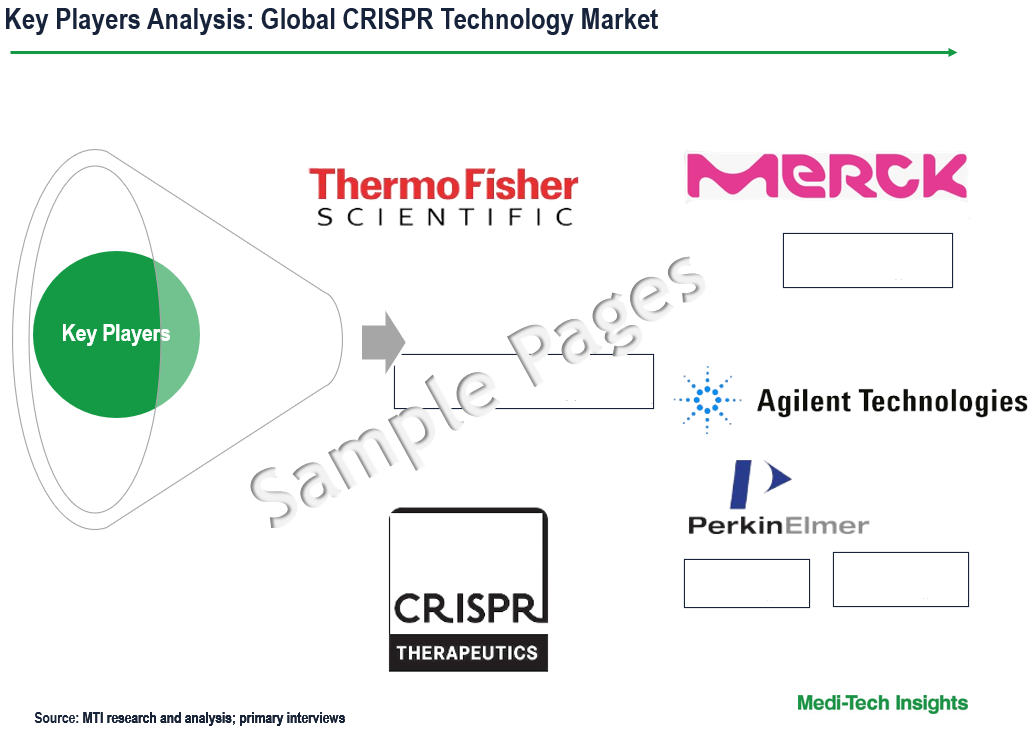
Get a sample report for competitive landscape analysis
Future Outlook of the CRISPR Technology Market
The global CRISPR technology market is expected to gain further momentum in the coming years due to the increasing prevalence of genetic disorders, rising chronic disease cases, and the development of novel therapeutics. These factors collectively contribute to the growth and evolution of the CRISPR technology market, shaping the landscape of genetic engineering and biotechnology.
CRISPR Technology Market Futures and Scope
| Report Scope | Details |
| Base Year Considered | 2023 |
| Historical Data | 2022 - 2023 |
| Forecast Period | 2024 - 2029 |
| CAGR (2024 - 2029) | 15-17% |
| Segment Scope | Product, Application, End User |
| Regional Scope |
|
| Key Companies Mapped | Thermo Fisher Scientific, Inc., Merck KGaA, Agilent Technologies, Inc., CRISPR Therapeutics AG, Genscript Biotech Corporation, Lonza Group, Ltd., PerkinElmer, Inc., Caribou Biosciences, Inc., Hera Biolabs, and OriGene Technologies, Inc., among others |
| Report Highlights | Market Size & Forecast, Growth Drivers & Restraints, Trends, Competitive Analysis |
Key Strategic Questions Addressed
-
What is the market size & forecast for the Global CRISPR Technology Market?
-
What are the historical, present, and forecasted market shares and growth rates of various segments and sub-segments of the Global CRISPR Technology Market?
-
How has COVID-19 impacted the Global CRISPR Technology Market?
-
What are the major growth drivers, restraints/challenges impacting the market?
-
What are the opportunities prevailing in the market?
-
What is the investment landscape?
-
Which region has the highest share in the global market? Which region is expected to witness the highest growth rate in the next 5 years?
-
Who are the major players operating in the market? What is the competitive positioning of key players?
-
Who are the new players entering the market?
-
What are the key strategies adopted by players?
- Research Methodology
- Secondary Research
- Primary Research
- Market Estimation
- Market Forecasting
- Executive Summary
- Market Overview
-
- Market Dynamics
- Drivers
- Restraints
- Key Market Trends
- Industry Speaks
- Market Dynamics
- Key Revenue Pockets
- Global CRISPR Technology Market - Size & Forecast (2021-2028), By Product Type
- Products
- CRISPR Kits & Enzymes
- CRISPR Libraries
- Other Products
- Services
- Cell Line Engineering
- gRNA Synthesis
- Screening and Validation
- Other Services
- Products
- Global CRISPR Technology Market - Size & Forecast (2021-2028), By Application Type
- Biomedical Applications
- Agricultural Applications
- Other Applications
- Global CRISPR Technology Market - Size & Forecast (2021-2028), By End User Type
- Pharmaceutical & Biotechnology Companies
- Academic & Research Institutes
- Other End Users
- Global CRISPR Technology Market - Size & Forecast (2021-2028), By Region
- North America (U.S. & Canada)
- Europe (UK, Germany, France, Italy, Spain, Rest of Europe)
- Asia Pacific (China, India, Japan, Rest of Asia Pacific)
- Rest of the World (Latin America, Middle East & Africa)
- Competitive Landscape
- Key Players and their Competitive Positioning
- Competitive Positioning of Key Players (2022)
- Offerings Assessment, By Player
- Key Strategies Assessment, By Player (2021-2023)
- New Product & Service Launches
- Partnerships, Agreements, & Collaborations
- Mergers & Acquisitions
- Geographic Expansion
- Key Players and their Competitive Positioning
- Key Companies Scanned (Indicative List)
- Thermo Fisher Scientific, Inc.
- Merck KGaA
- Agilent Technologies, Inc.
- CRISPR Therapeutics AG
- Genscript Biotech Corporation
- Lonza Group, Ltd.
- PerkinElmer, Inc.
- Caribou Biosciences, Inc.
- Hera Biolabs
- Other Prominent Players
The study has been compiled based on extensive primary and secondary research.
Secondary Research (Indicative List)
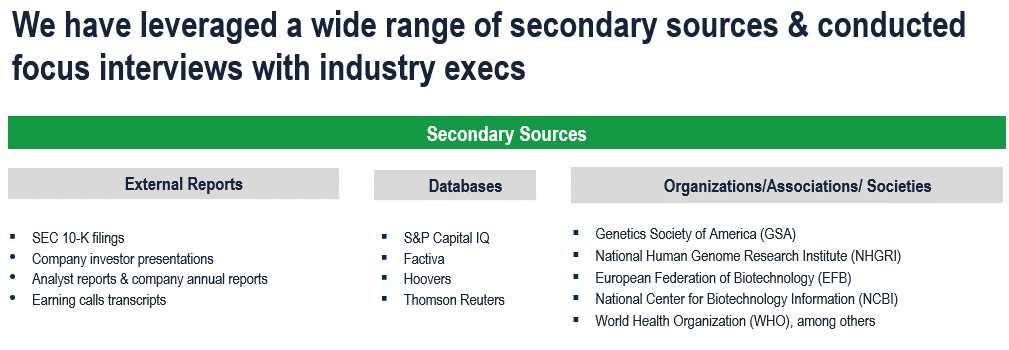
Primary Research
To validate research findings (market size & forecasts, market segmentation, market dynamics, competitive landscape, key industry trends, etc.), extensive primary interviews were conducted with both supply and demand-side stakeholders.
Supply Side Stakeholders:
- Senior Management Level: CEOs, Presidents, Vice-Presidents, Directors, Chief Technology Officers, Chief Commercial Officers
- Mid-Management Level: Product Managers, Sales Managers, Brand Managers, Business Development Managers, Consultants
Demand Side Stakeholders:
- Stakeholders in Pharmaceutical and Biotechnology Companies, Academic and Government Research Institutes, Contract Research Organizations (CROs) and Other End Users
Breakdown of Primary Interviews
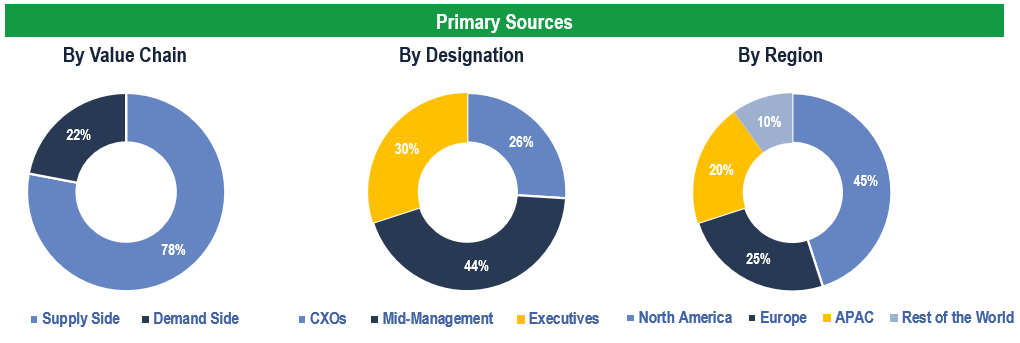
Market Size Estimation
Both ‘Top-Down and Bottom-Up Approaches’ were used to derive market size estimates and forecasts.
Data Triangulation
Research findings derived through secondary sources & internal analysis were validated with Primary Interviews, Internal Knowledge Repository, and Company Sales Data.

